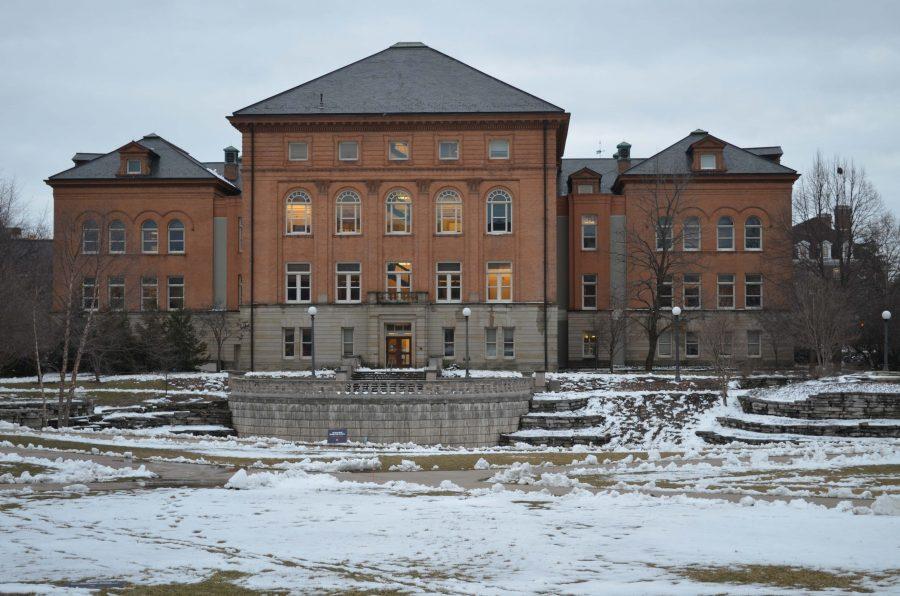Sesquicentennial honored with book of snapshots
The sesquicentennial is commemorated with a book featuring essays that capture the past 150 years of the University’s innovation.
Feb 6, 2017
Last updated on Feb. 28, 2017 at 03:08 p.m.
The MRI, the LED light and even the internet all have one thing in common — they originated at the University.
John Milton Gregory knew C-U was the right place for a university to be built, but there was no way he could have known that the end of the bidding war meant the beginning of an era.
The bidding war between several Illinois cities took place about 150 years ago. It secured C-U as home to a public university paid for by the Morrill Act. Since then, there have been countless inventions, Nobel Prizes and novel ideas created on campus.
Frederick E. Hoxie, professor emeritus of history at the University, was challenged with creating something to celebrate the University’s sesquicentennial. He wanted to create something that was more than a historical account, something that represented the synergy of ideas that were decades in the making. “University of Illinois: Engine of Innovation” was the end result.
Get The Daily Illini in your inbox!
“It’s a collection of snapshots; we’re telling a big story by assembling a lot of little ones. And so this is not a comprehensive history of the University,” Hoxie said. “The effort of selecting the stories here was to try to talk about significant innovations but also to try to describe the range of innovations across all the different disciplines.”
The book features 22 complete essays and 24 descriptions of topics, or “sketches.” The essays are no longer than 10 to 12 pages and the sketches no longer than two. The book also includes a variety of photographs, some dating back to the early 1900s. Contributors range from University professors to undergraduate students.
One innovation the book describes is Mosaic, one of the very first internet browsers. Mosaic is credited with popularizing the World Wide Web because it featured in-line graphics and other features that made using the internet easier.
Jimena Canales, professor of history at the University, researched Mosaic and wrote the essay about it for the book.
“One of the things that interested me in doing this article was to consider Mosaic as more than just an interface. I started thinking seriously about what an interface is beyond computers, so an interface can be a doorknob, it can be a window … One of the really wonderful, and eerie, aspects about interfaces, is that they kind of disappear. You don’t have novels written about doorknobs or computer browsers, but if they weren’t there, you couldn’t go places. If you couldn’t open a door, history wouldn’t happen,” Canales said.
History wouldn’t happen without Mosaic, and according to many contributors, the same goes for almost every innovation and person mentioned in the book. Hoxie stressed the idea of synergy between all of the innovations mentioned in the collection.
“Together, I hope they convey this larger message about innovation; that it’s a long-term process, it involves synergy … it involves a connection to the world around you,” Hoxie said. “Someone may think of C-U as an ivory tower, but it really is a place that’s constantly interacting with the world around it.”
In one essay written by Leslie Reagan, a history professor at the University, she lays out the story of Timothy Nugent and how the University came to be the most accessible campus in the world.
Lower curbs, buses with wheelchair lifts and a comprehensive program for those with disabilities have all become the national standard, but they originated here.
“The campus created a space where they could move around easily and it was accessible. Many of the students then took those ideas to other places, and some of them actually became involved in policy changes at the state level and the national level,” Reagan said.
A clear theme is present throughout the collection, one of the importance of resources for innovation. Hoxie mentioned an essay about the cultivation of a library on campus and how it proved to be a resource that would ultimately produce Pulitzer Prize-winning authors.
“Some students might be able to afford a PC or an iPhone, but if they really want to innovate beyond what those tools permit, we have to collaborate,” Canales said. “The power of having a well-funded institution that provides materials and resources — such as supercomputers — that are otherwise inaccessible to private individuals, is tremendous.”
The book can be pre-ordered for delivery by the end of February on the University of Illinois Press website. The physical copy is available for $29.95 and the e-book is available for $26.96. The book is part of a series of projects funded to celebrate the University’s sesquicentennial.
“I think everyone who experiences life in C-U thinks they know the University. They know their experience of the University and their version of the University,” Hoxie said. “I hope what it’ll do is make people aware of the breadth and scope of the University, and I hope in the end they’ll appreciate more fully that the University is a center of innovation, that the innovation is key.”






